For homeowners, privacy has become more important than ever. Therefore, using shrubs to create privacy adds a living element that a fence or wall can’t offer. Tall privacy shrubs have many benefits, including increasing the value of your home, keeping your yard and home cooler, and protecting yourself from sun and wind.
20 Tall Privacy Shrubs
When choosing privacy shrubs, you need to consider the growth rate and mature size as well as the ornamental attributes, amount of maintenance required, and multi-seasonal interest. Here are the top 20 tall privacy shrubs to grow.
1. Arborvitae

Arborvitae (Thuja spp) is a coniferous tree or shrub with green, blue-green, or gold evergreen foliage. However, not all arborvitae varieties are best for use in privacy shrubs. The fast grower “Green Giant” is a good choice, reaching 50 to 60 feet tall with a spread of 12 to 20 feet.
You can plant the green giant variety 5-6 feet apart, and they will grow together into a hedge without gaps. Although planting them close to each other will not decrease their height, you can expect around 3-5 feet of new growth annually until they reach their maximum height.
USDA Growing Zone: 2-7
Sun Exposure: Full sun to partial shade
Soil Requirements: Moist, well-drained, loamy soil,
2. Skip Laurel Shrub
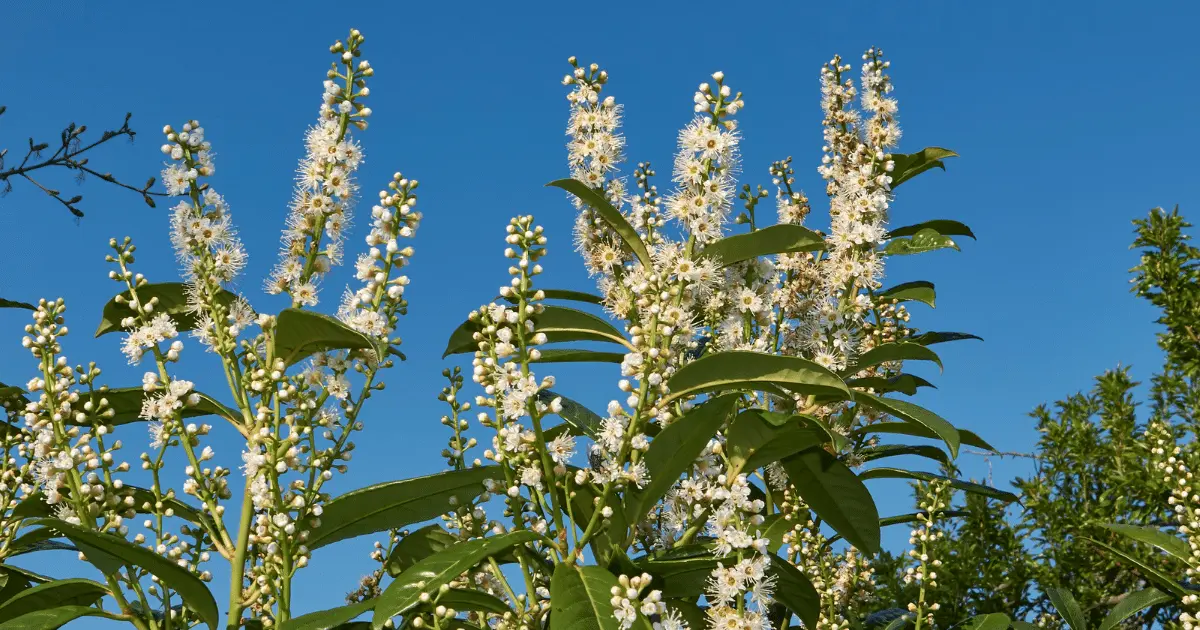
Skip Laurel Shrub (Prunus laurocerasus) is a large evergreen shrub that grows 2 feet a year. It has glossy dark-green leaves that always look lush and healthy. It’s a tall flowering privacy shrub.
If left untrimmed, it will reach 10 to 18 feet in height and will flourish in full sunlight per day. Skip laurel shrubs can also handle a lot of variations concerning sunlight and soil quality and can withstand pollution.
USDA Growing Zone: 5-10
Sun Exposure: Full sun, partial shade
Soil Requirements: Sandy, clay, alkaline, and acidic soil.
3. Dappled Willow
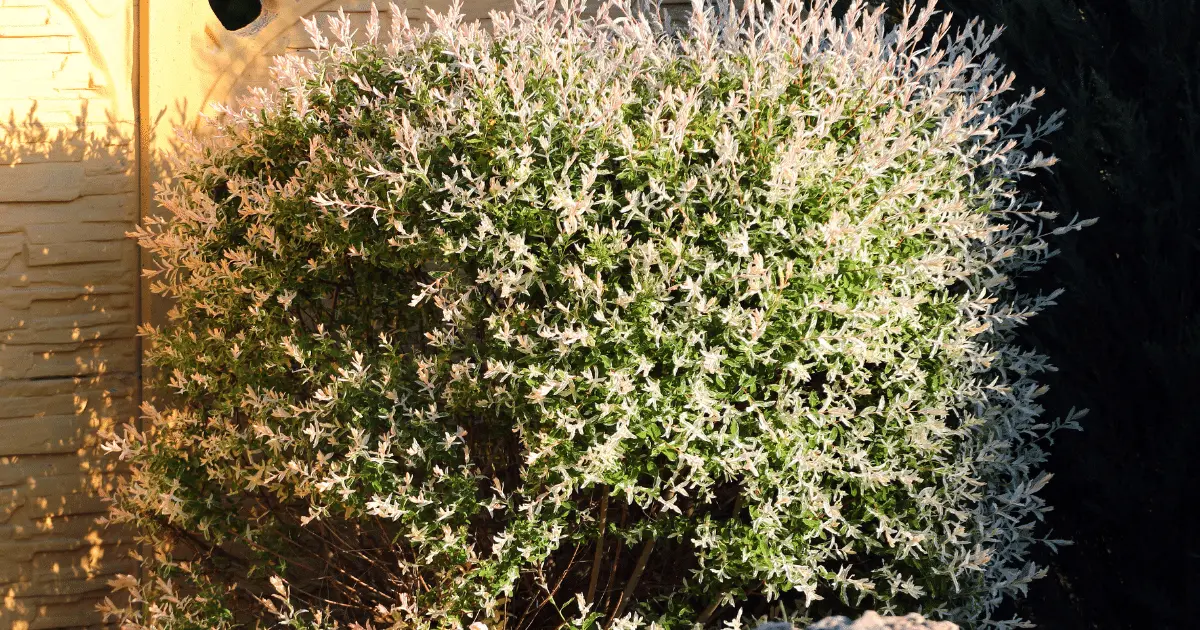
Dappled Willow (Salix Integra ‘Hakuro-Nishiki) is a deciduous shrub grown for its pink and white variegated leaves, which are pinker in spring and change to white and green in winter. This shrub grows up to 4-6 ft high (120-180 cm) and 5-7 ft across (150-210 cm) and performs best in full sun to part shade in fertile, moist, well-drained soils.
USDA Growing Zone: 7
Sun Exposure: Full sun
Soil Requirements: Fertile, moist, well-drained soil.
4. Ninebark

Ninebark (Physcarpus) is a white-flowering native plant widely used in landscaping. Ninebark gets its name from its unique exfoliating bark, which peels back in thin layers as its branches mature. The tree blooms in late spring with clusters of white or pink blooms, and it bears red fruit in late summer and autumn, attracting birds.
Like many tall privacy shrubs, ninebark grows from 10 feet high to 6-5 feet wide at maturity. It is best planted in the early spring while the bush is still dormant.
USDA Growing Zone:2-8
Sun Exposure: Full, partial
Soil Requirements: Clay, loamy
5. Elderberry

Elderberry (Sambucus spp) is a genus of flowering plants in the family Adoxaceas. The tree is identified by its serrated leaves that grow in groups of three to nine leaves on each side of a stem.
It has a moderate growth rate of 6 feet (check) in the first few years of its growth. Elderberry is a popular tall flowering privacy shrub. Elderberry shrubs are not fussy and can tolerate many environments. For the best flowers and berries, choose an open area with plenty of full sun daily.
USDA Growing Zone: 3-9
Sun Exposure: Full sun, partial shade
Soil Requirements: Moist, well-drained
6. Yew

Yew (Taxus baccata spp) is an evergreen tree representing varieties of evergreen trees and shrubs that are easy to care for and can tolerate a wide range of growing conditions. Yew plants are highly adaptable for landscaping and grow 4 to 60 feet tall and 4 to 20 feet wide, depending on the variety. The tree can also make an excellent addition to a garden border when used in a mass painting.
Yew tolerates several soil types as long as the soil has good drainage. It thrives best in rich, loamy soil with a neutral to slightly alkaline soil ph of 5.0 to 8.0. It also prefers moderate soil moisture but tolerates short periods of drought or overwatering as long as the roots are not left standing in the water.
USDA Growing Zone: 2-10
Sun Exposure: Full sun, partial shade
Soil Requirements: Loamy, moist, well-drained.
7. Pyracantha

Pyracantha (Pyracantha spp) is a beautiful, easy-going, wildlife-friendly shrub suitable for most gardens. Pyracantha is grown as hedging, a free-standing shrub, or trained against a wall. It provides color across the seasons with white blossom in spring, dense green foliage, and a bounty of vibrant berries.
Most pyracantha varieties grow to several meters high, but there are some bushy and compact growing varieties too. This friendly shrub is best grown at the back of a border or as a single plant in the lawn to develop into a large bushy shrub.
USDA Growing Zone: 6-9
Sun Exposure: Full sun
Soil Requirements: Dry, free-draining, and heavy clay soil
8. Canadian Hemlock
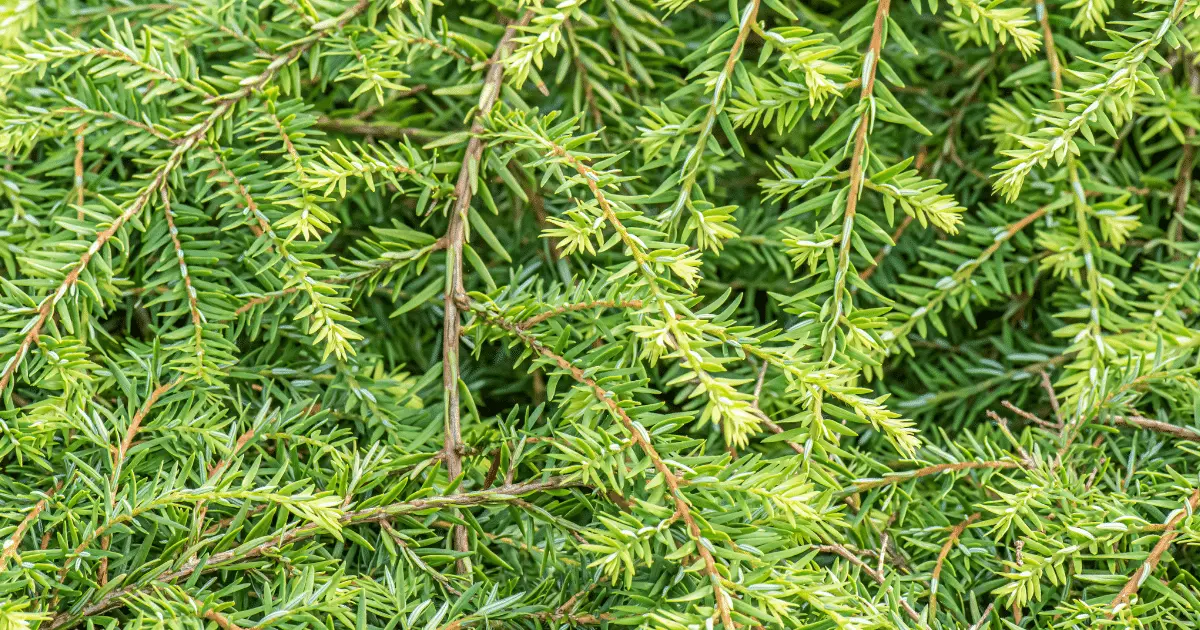
Canadian Hemlock (Tsuga Canadensis) is a coniferous tree native to eastern North America. The tree is pyramidal or conical in shape, and their smell plus fragrant two-toned green needles give them a fine texture.
Canadian hemlock can reach 10 feet tall or higher in the wild with a spread of 25 to 35 feet. The tree produces tiny tan-colored, pendant-shaped seed-bearing cones that ripen in the fall and releases seed during the winter.
USDA Growing Zone: 3-7
Sun Exposure: Full sun, partial shade
Soil Requirements: Moist soil.
9. Burning Bush
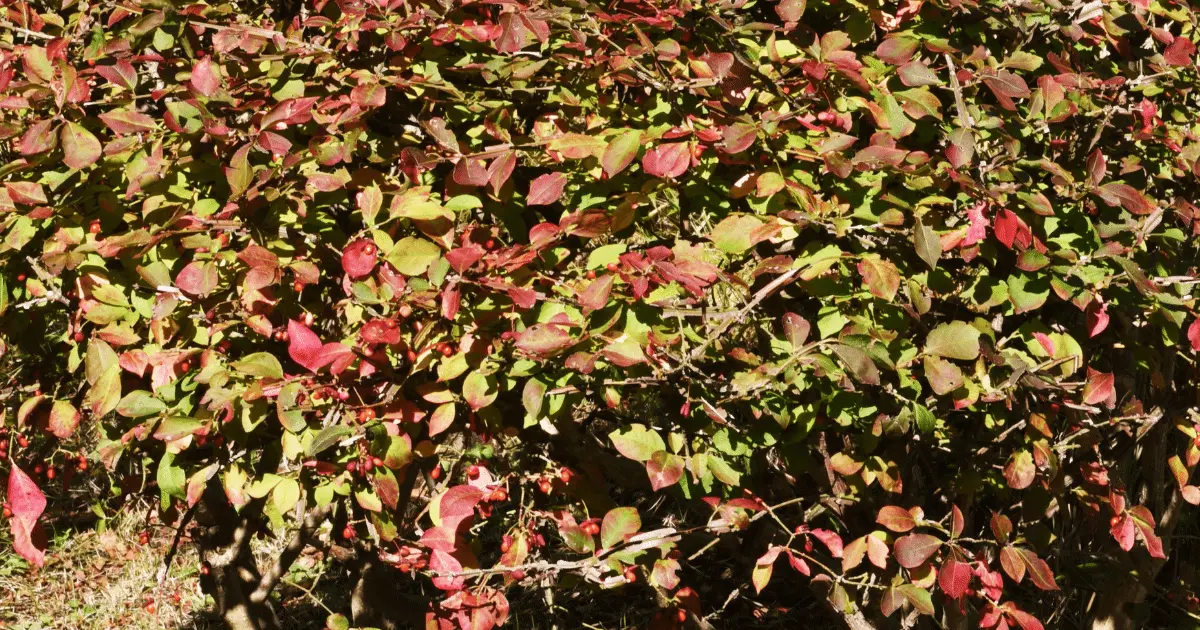
Burning Bush (Euonymus alatus) is known for their striking fall foliage, brilliant flower display, and medium-green elliptical leaves. It is an easy-to-grow shrub that will thrive best in any moist, well-drained soil in full sun or partial shade location. Burning bush is best planted in the fall or spring from a container-grown nursery plant and will survive for decades if maintained properly.
USDA Growing Zone: 4-8
Sun Exposure: Full sun to partial shade
Soil Requirements: Sandy, loamy soil.
10. Leylandii

Leylandii (Cupressus x leylandii) is an aggressive grower and a fast-growing coniferous evergreen tree used in horticulture, primarily for edges and screens. The scaly reddish-brown bark displays attractive splays of gray-green needles that typically live 20-50 years, depending on the environment.
The best time to plant leylandii is during its dormancy in mid-fall. The tree should be planted in an area with well-drained soil that receives full sunlight to partial shade. Do not plant this tree directly on the property line because it is fast-growing and can grow onto your neighbor’s property.
USDA Growing Zone: 6-10
Sun Exposure: Full sun
Soil Requirements: Clay, loamy, sandy soil
11. Loropetalum
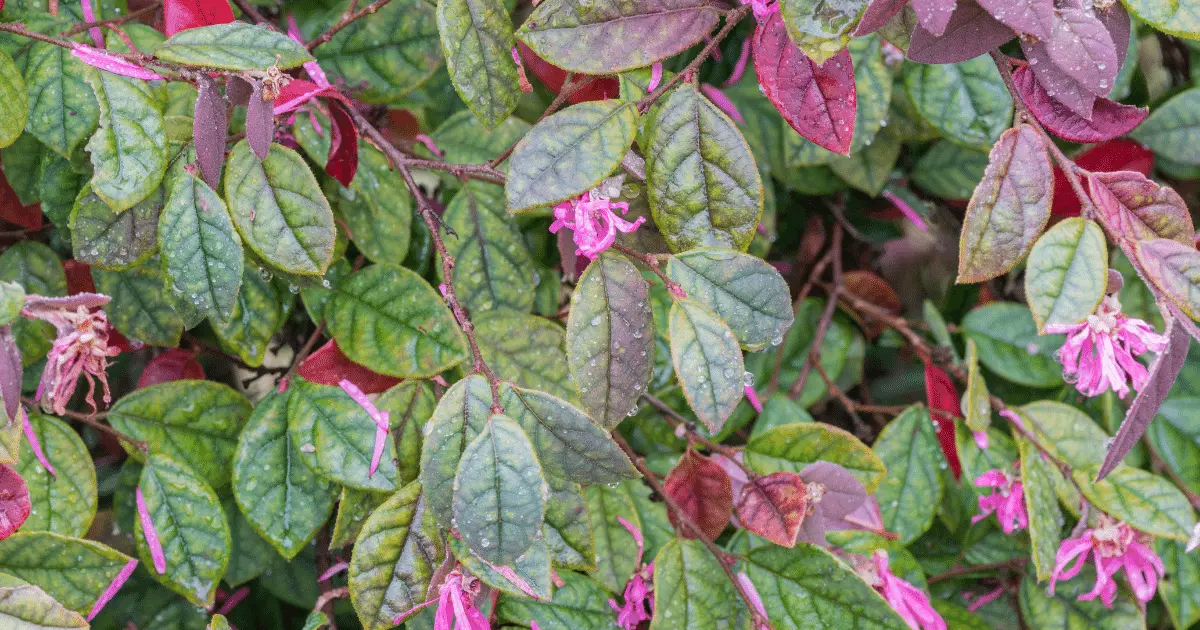
Loropetalum (Loropetalum Chinese), also called Chinese fringe flower, strap flower, and Chinese witch hazel, are evergreen multi-stemmed shrubs of broadleaf variety well-known for their delicate fragrant blooms. Loropetalums are considered low-maintenance and hardy, but showy shrubs and flowers are adaptable to a wide range of light, soil, and moisture conditions.
USDA Growing Zone: 7-9
Sun Exposure: Full sun to partial shade
Soil Requirements: Rich, well-drained, loamy, acidic soil.
12. Red Twig Dog Wood

Red Twig Dog Wood (Cornus sericea) is another tall privacy shrub to grow that will brighten your landscape with its bright red branches. It can also provide four-season interest with beautiful spring blossoms, variegated leaves during summer, and berries from summer to fall. Depending on the variety, this shrub can bear either dark green or variegated leaves and small white flowers that form in flat clusters.
USDA Growing Zone: 2-7
Sun Exposure: Full sun to partial shade
Soil Requirements: Rich, fertile, moist soil
13. Common Purple Lilac
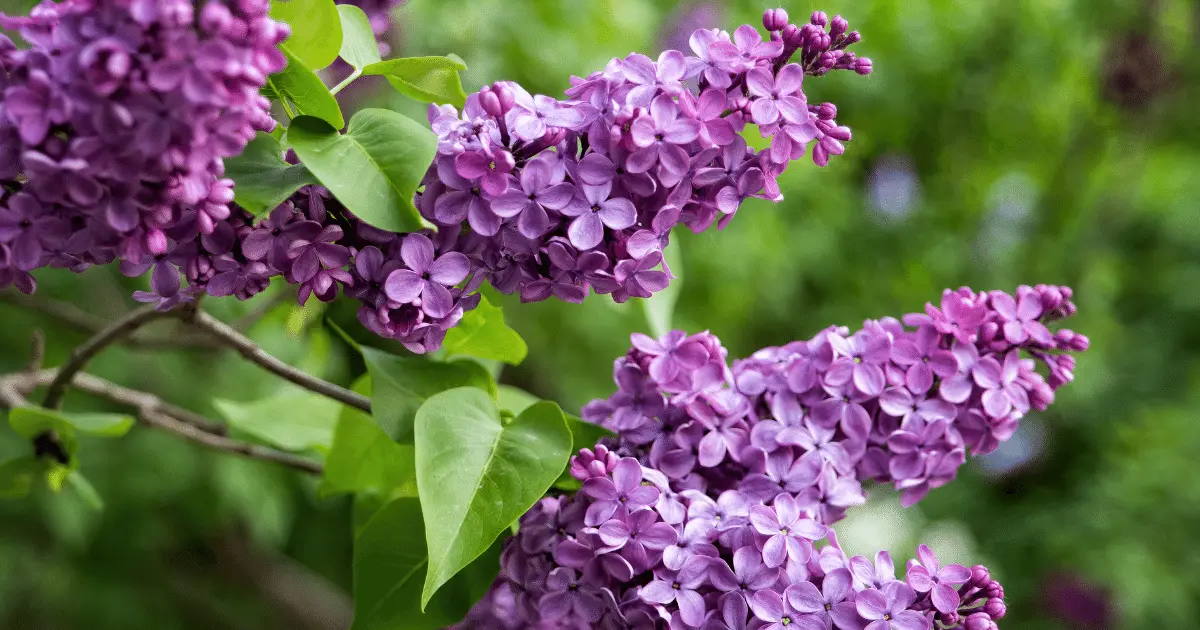
Common Purple Lilac (Syringa vulgaris) is another excellent choice of tall privacy shrub that grows well throughout most of the United States, except Southern states, the West Coast, and the Northernmost parts of the Midwest. The fascinating thing about the common purple lilac is its springtime bloom. Its wonderful fragrant flowers may be single or double and are available in a wide range of colors, including white, cream, rose, magenta, pinkish-purple, lavender, and purple.
USDA Growing Zone: 3-7
Sun Exposure: Partial to full sun
Soil Requirements: Fertile, humus-rich, alkaline to neutral, dry to medium, well-drained soil.
14. Forsythia
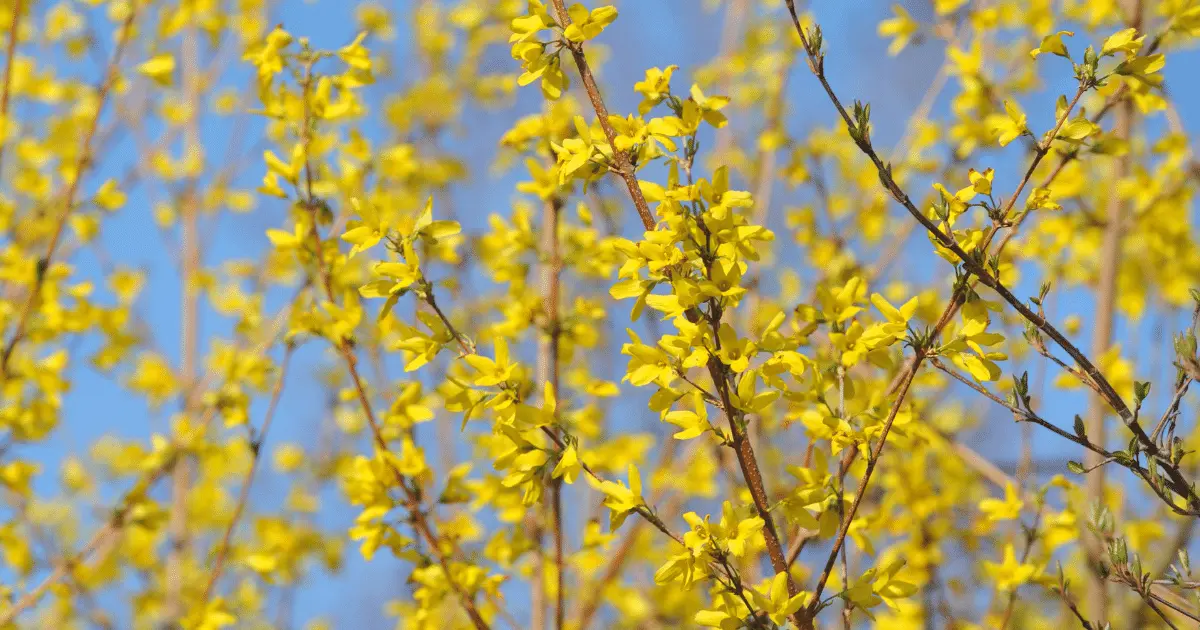
Forsythia (Forsythia spp) is a fast-growing flowering shrub belonging to the Olive family. They are low-maintenance shrubs that can add 24 inches in a year, especially the larger varieties. Forsythias are best planted in late fall or early spring while the plants are still dormant, but gardeners in frost-free climates can also plant them in winter.
Forsythia bushes are often used as a living privacy wall in the summer and fall after they have fully leafed out. They are relatively tolerant of poor garden soil and have some drought tolerance once established.
USDA Growing Zone: 3-8
Sun Exposure: Full sun
Soil Requirements: Moist, well-drained soil.
15. Mock Orange
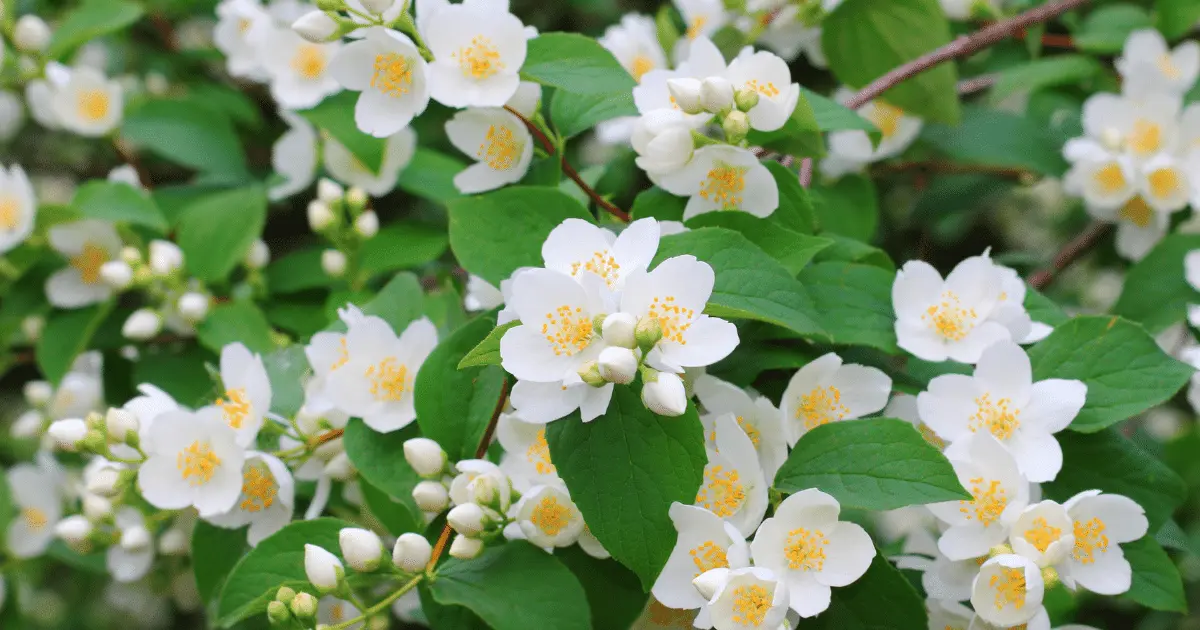
Mock orange (Philadelphus coronaries) is a late-spring blooming deciduous bush used in groups as screening or simply as a stand-alone specimen plant. This tree derives its name from the fragrant white flowers, which are thought to resemble orange blossoms in some varieties.
Mock orange shrubs are attractive in the spring, and they can be planted in groups to form a loose privacy hedge for summer, and their blossoms are often used as cut flowers. These shrubs can grow in full sun to partial shade, requiring at least four hours of direct sunlight on most days.
USDA Growing Zone: 4-8
Sun Exposure: Full sun, partial shade
Soil Requirements: Well-drained, loamy soil.
16. Cotoneaster
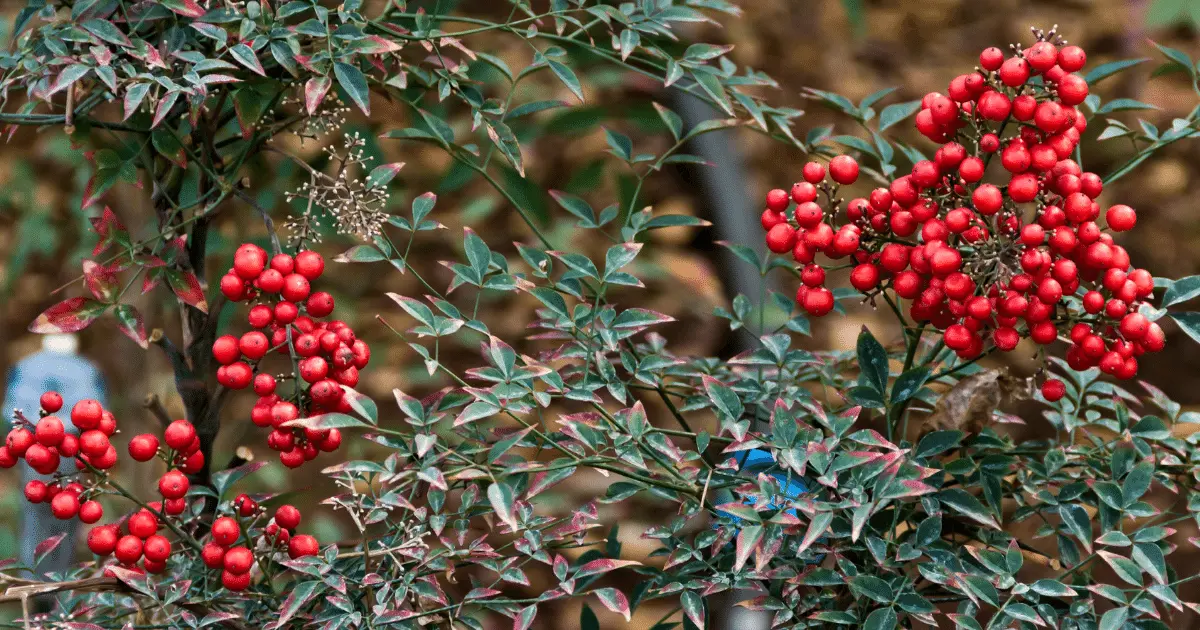
Cotoneaster (Cotoneaster horizontalis) is a beautiful branched evergreen shrub with arching stems and a low-growing habit. They bear a long season of interest due to their prolific summer flowers, followed by deep red berries, which remain on the plant from autumn through winter. Cotoneasters are wildlife-friendly, and most varieties will thrive in moist but well-drained soil in full sun or partial shade.
USDA Growing Zone: 5-7
Sun Exposure: Full sun to partial shade
Soil Requirements: Loamy, well-drained, evenly moist soil.
17. Waxleaf Pivot Hedge
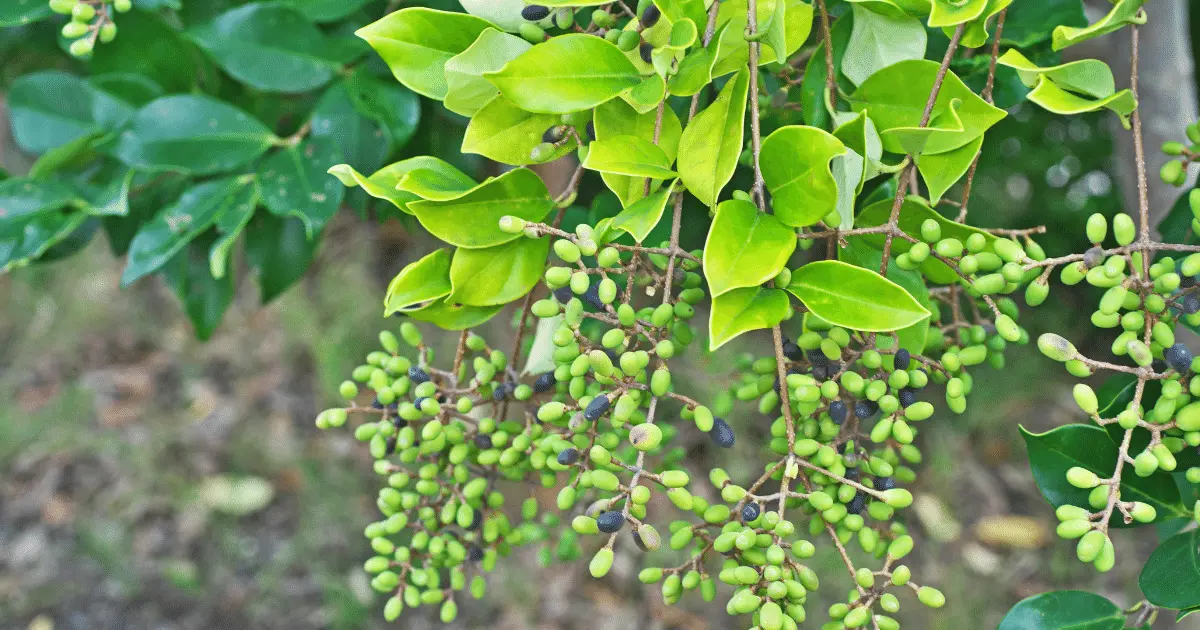
Waxleaf Pivot Hedge (Ligustrum japonicum Texanum’) is an evergreen with pretty blossoms and a lovely scent. This shrub thrives best in Southern states and along the West coast but might do okay as far North as Virginia on the East coast. Waxleaf privet overgrows, prunes nicely, and has flowers that lead to fruit clusters that last through the winter.
USDA Growing Zone: 7-10
Sun Exposure: Full sun to partial shade
Soil Requirements: Well-drained, rich soil
18. Lemon Lights Azalea Shrub
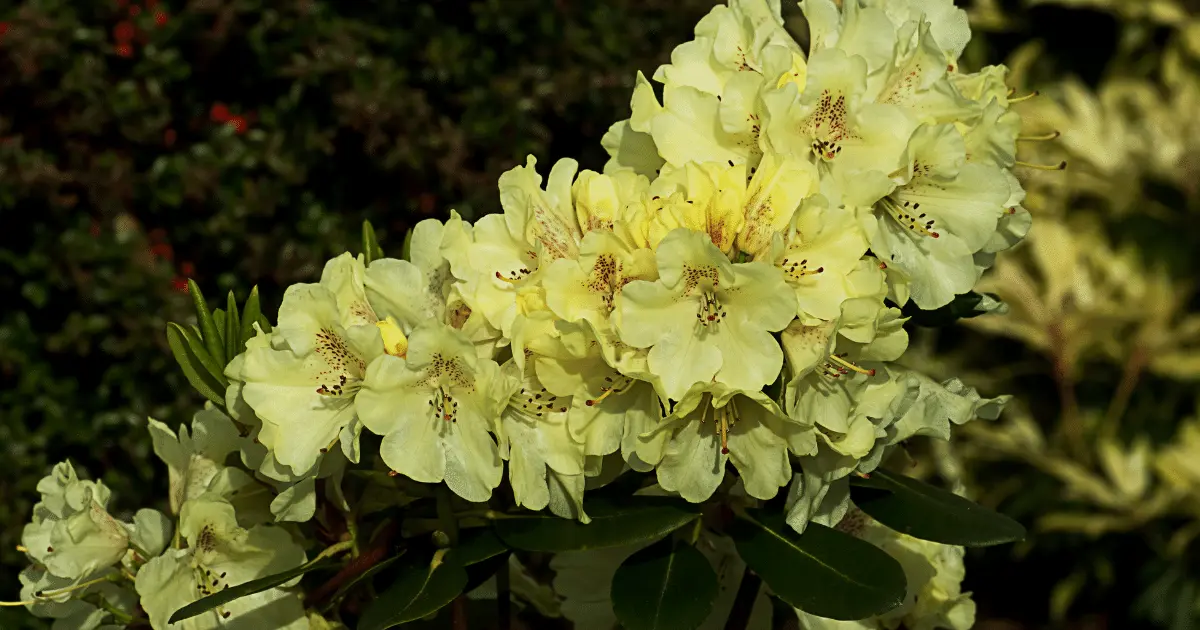
Lemon Light Azaleas (Rhododendron ‘Lemon Lights’) are clusters of bright yellow, fragrant flowers that bloom in mid-spring before the leaves emerge. They require rich, moist, acidic soils for the best growth of 6 feet and 4 feet wide.
The shrub does best in full sun to partial shade. However, you may want to keep it from hot, dry locations that receive direct afternoon sun or reflected sun as against the south side of a white wall. It is very fussy about its soil conditions and must have rich, acidic soils to ensure optimal growth.
USDA Growing Zone: 4
Sun Exposure: Partial to full sun
Soil Requirements: Moist, well-drained
19. Oakleaf Hydrangea Shrub

Oakleaf Hydrangea shrub (Hydrangea quercifolia) is a versatile shrub that grows well and doesn’t require extensive care. Hydrangea spreads out nicely horizontally and vertically, and it also features stunning leaves that look similar to the leaves you find on an oak tree.
The shrub is prized for its long-lasting flower that emerges white but gradually transitions to purplish pink. It grows 4 to 8 feet tall, has a rounded growth habit, and spreads by suckering.
USDA Growing Zone: 5-9
Sun Exposure: Full, partial
Soil Requirements: Moist, well-drained
20. Gulf Stream Heavenly Bamboo

Gulf Stream Heavenly Bamboo (Nandina Domestica ‘Gulf stream’) is a compact, bushy, evergreen shrub adding multi-season beauty to the garden. This shrub attracts bees and other pollinators, and the flowers are sometimes followed by abundant clusters of red berries, which persist throughout fall and winter.
This shrub grows 1.2 m tall with pinnate leaves divided into lance-shaped leaflets. The new leaves’ growth emerges a bronze-orange color in spring, turning green with age but retaining a red-orange flush. While in autumn and winter, the foliage turns red and gold.
USDA Growing Zone: 6-9
Sun Exposure: Full sun to light shade
Soil Requirements: Average, moist, well-drained soils.
